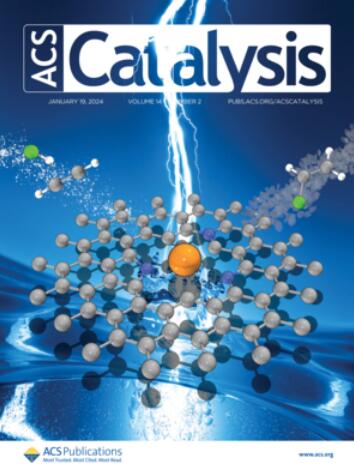Enzyme-Catalyzed Molecular Skeletal Editing: α-Pyrone to Furanone
IF 13.1
1区 化学
Q1 CHEMISTRY, PHYSICAL
引用次数: 0
Abstract
The construction and editing of heterocycles are fascinating and challenging in both biosynthesis and chemical synthesis. The furan ring, as a fundamental structural unit, plays a significant scaffolding role in many bioactive natural products. In this study, we report a furan assembly strategy in linfuranone A (1) and its associated natural products, characterized by the presence of a furanone at the terminus of their linear polyketide chains. An FAD-dependent monooxygenase, LfnO1, performs the skeletal editing of α-pyrones to the corresponding furanones. We show through combinatorial expression, in vitro biochemical assays, isotope labeling experiments, and comprehensive structural prediction analysis that the multifunctional LfnO1 converts α-pyrone substrates to furanone products displaying two distinct levels of oxidation via ring contraction. Additionally, we demonstrate that LfnO1 possesses broad substrate compatibility, enabling it to recognize and transform a variety of α-pyrone natural products commonly found in nature. Our findings shed light on an unconventional approach to furanone formation in natural products and show the great potential of LfnO1 as a skeletal editing tool in biocatalysis.

酶催化的分子骨架编辑:α-吡酮到呋喃酮
杂环的构建和编辑在生物合成和化学合成领域都是一个具有挑战性的课题。呋喃环作为一种基本结构单元,在许多具有生物活性的天然产物中起着重要的支架作用。在这项研究中,我们报道了呋喃在林呋喃酮a(1)及其相关天然产物中的组装策略,其特征是在其线性聚酮链的末端存在呋喃酮。fad依赖的单加氧酶LfnO1将α-吡咯酮骨架编辑为相应的呋喃酮。我们通过组合表达、体外生化分析、同位素标记实验和综合结构预测分析表明,多功能LfnO1通过环收缩将α-吡酮底物转化为呋喃酮产物,表现出两种不同水平的氧化。此外,我们证明了LfnO1具有广泛的底物相容性,使其能够识别和转化自然界中常见的各种α-吡酮天然产物。我们的发现揭示了天然产物中呋喃酮形成的一种非常规方法,并显示了LfnO1作为生物催化中骨骼编辑工具的巨大潜力。
本文章由计算机程序翻译,如有差异,请以英文原文为准。
求助全文
约1分钟内获得全文
求助全文
来源期刊

ACS Catalysis
CHEMISTRY, PHYSICAL-
CiteScore
20.80
自引率
6.20%
发文量
1253
审稿时长
1.5 months
期刊介绍:
ACS Catalysis is an esteemed journal that publishes original research in the fields of heterogeneous catalysis, molecular catalysis, and biocatalysis. It offers broad coverage across diverse areas such as life sciences, organometallics and synthesis, photochemistry and electrochemistry, drug discovery and synthesis, materials science, environmental protection, polymer discovery and synthesis, and energy and fuels.
The scope of the journal is to showcase innovative work in various aspects of catalysis. This includes new reactions and novel synthetic approaches utilizing known catalysts, the discovery or modification of new catalysts, elucidation of catalytic mechanisms through cutting-edge investigations, practical enhancements of existing processes, as well as conceptual advances in the field. Contributions to ACS Catalysis can encompass both experimental and theoretical research focused on catalytic molecules, macromolecules, and materials that exhibit catalytic turnover.
 求助内容:
求助内容: 应助结果提醒方式:
应助结果提醒方式:


